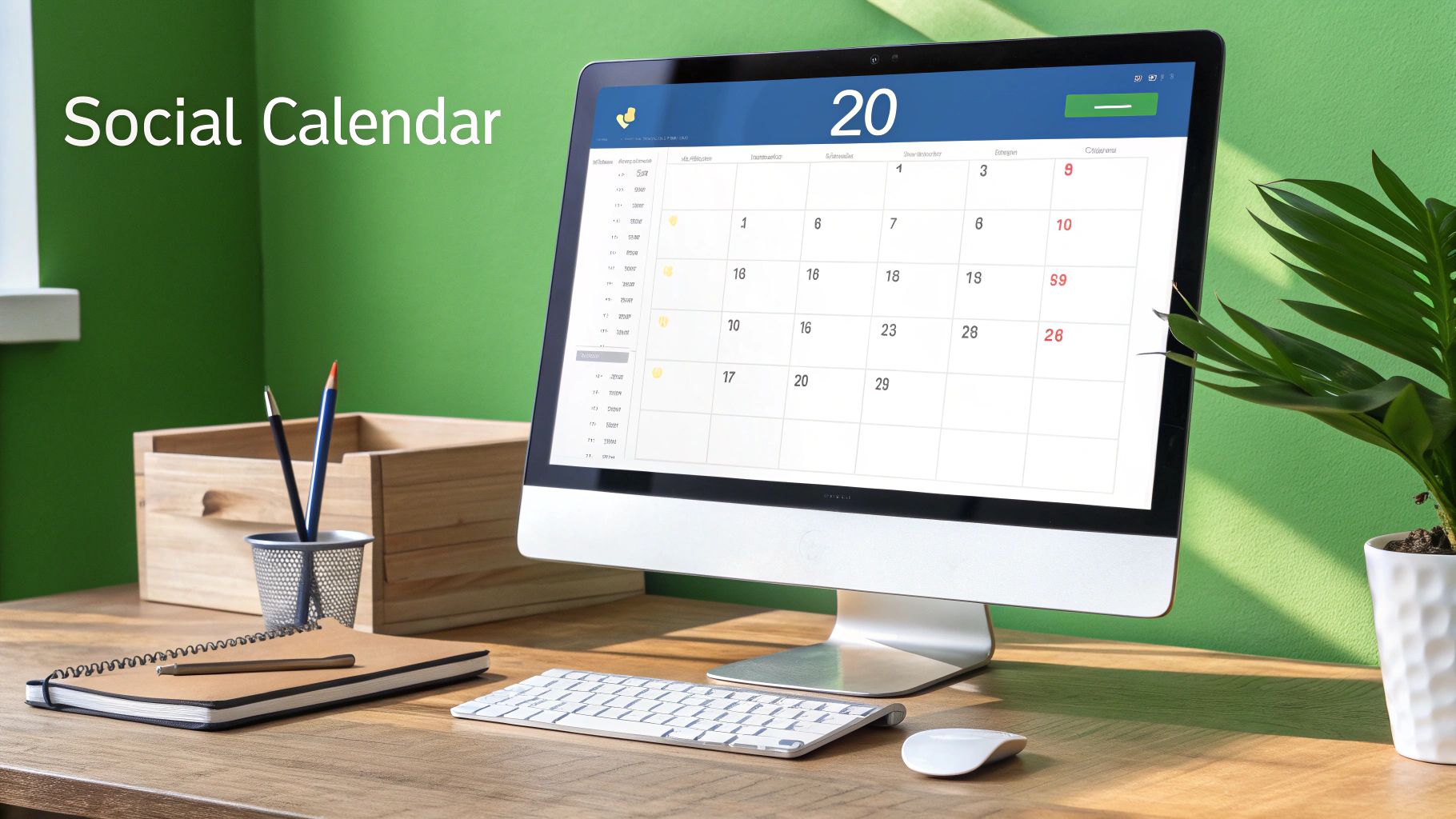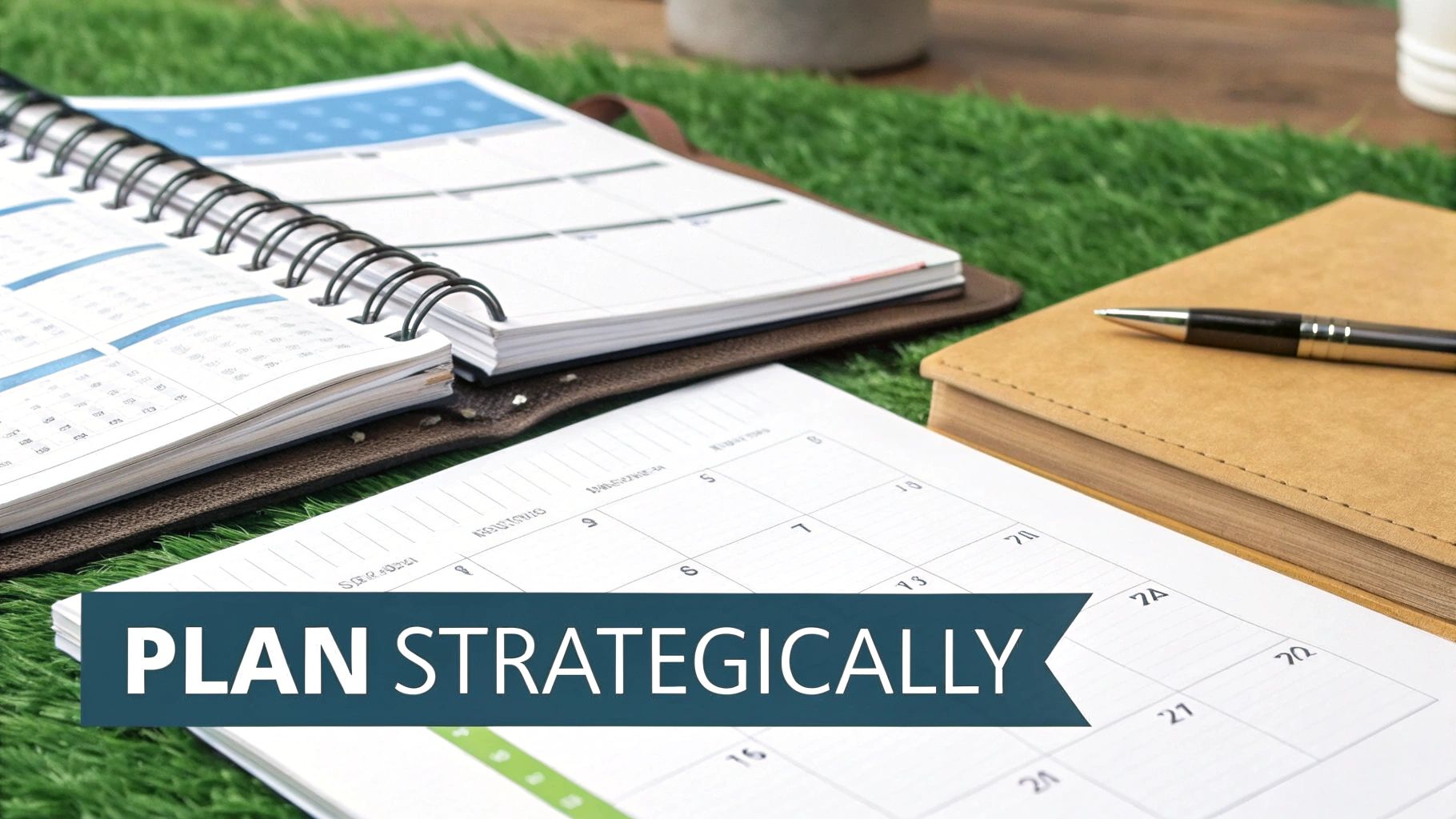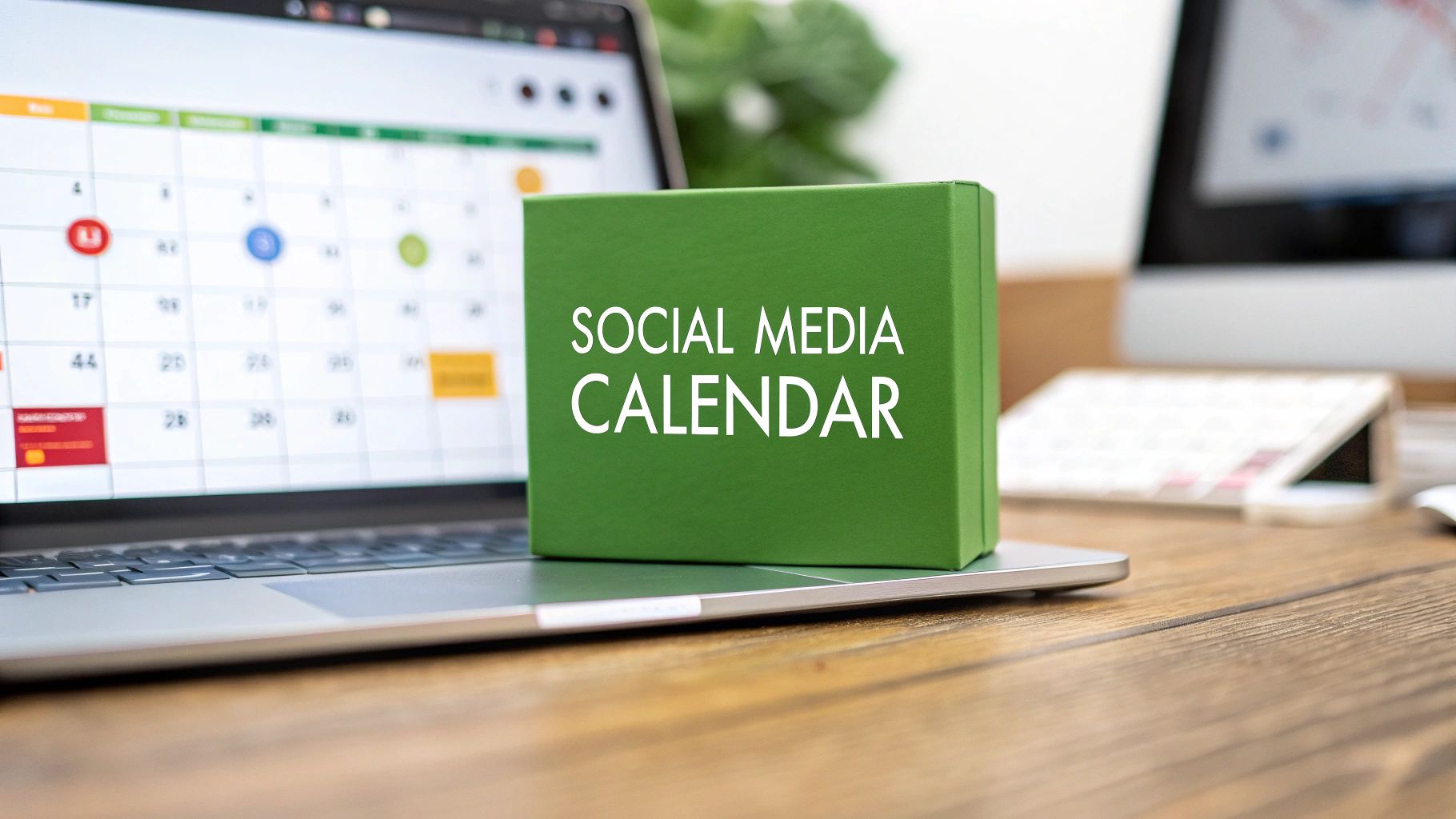Social Media Content Calendar: Proven Strategies
Why a Social Media Content Calendar Drives Real Results
A well-structured social media content calendar is essential for a successful social media strategy. It’s the key difference between random posting and a targeted approach that delivers tangible results. Think of it as your roadmap, guiding your social media efforts and ensuring you reach your goals: increased engagement, greater brand awareness, and ultimately, business growth. This organized planning eliminates common problems like missed opportunities, inconsistent content, and last-minute scrambling.
Benefits of a Social Media Content Calendar
A social media content calendar helps you shift from sporadic posting to strategic communication. It helps your content consistently connect with your target audience. Imagine navigating a new city without a map. You'll likely get there eventually, but it'll take longer and involve wrong turns. A content calendar is that crucial map, streamlining your efforts for maximum impact. Plus, planning your content frees up your time and energy so you can focus on overall strategy and audience engagement.
- Consistency: Regular posting keeps your audience engaged and builds brand recognition.
- Efficiency: Planning allows for creating content in batches and scheduling it strategically.
- Alignment: A calendar keeps your social media activities aligned with your marketing goals.
- Adaptability: While a calendar offers structure, it also allows flexibility for trending topics and real-time events.
Maximizing Your Online Presence
A social media content calendar is vital for maximizing your online presence and engagement. Planning ahead allows you to schedule content, ensuring consistency and tailoring messages for specific audiences. Businesses can boost efficiency by up to 40% by managing multiple social media channels at once. With about 5.42 billion social media users worldwide as of 2025, and the average person using roughly 6.83 different platforms monthly, a structured content plan is essential. Find more detailed statistics here. Interested in mastering calendar setup? Check out this guide: How to master the setup of a social media calendar. Companies using calendars can better align content with trends and events, improving audience engagement and potentially boosting sales.
From Rigid Schedules to Dynamic Roadmaps
Successful brands don’t see their social media content calendars as rigid schedules. They view them as dynamic roadmaps that provide direction but allow for adjustments based on performance and opportunities. This flexibility lets you incorporate trending topics, react to current events, and take advantage of viral moments. Like a GPS recalculating a route around an obstacle, a dynamic calendar helps you adapt and stay on track towards achieving your social media goals. This adaptability keeps your strategy relevant and engaging in the constantly changing digital world.

Building Your Calendar Framework That Actually Works

Stop starting from scratch with every social media campaign. Focus on building a strong social media content calendar that acts as your team's central resource. This section helps you build a framework that not only works but thrives, adapting to different content types and new opportunities.
Defining Your Content Pillars
First, define your content pillars. These are the core themes representing your brand and connecting with your audience. They form the bedrock of your social media strategy.
For example, a fitness apparel brand might use workout routines, healthy eating, and motivational stories as content pillars. Focusing on these key areas creates a consistent brand identity and provides valuable, expected content. This foundation makes planning individual posts much easier.
Planning Your Content Mix
A successful social media presence needs a diverse content mix. Use a variety of formats like text posts, images, videos, and interactive elements like polls and quizzes.
Also, balance evergreen content (timeless and always relevant) with time-sensitive campaigns for specific events or promotions. You might share evergreen social media best practices alongside a limited-time contest for a new product. This keeps your content engaging and addresses both long-term strategy and short-term goals.
Establishing Realistic Posting Frequency
Finding the right posting frequency is essential. Quality over quantity is key. Focus on a frequency your team can manage without sacrificing content quality.
Start with a manageable schedule like 3-4 posts per week and track engagement. Then, gradually increase posting as resources allow. This data-driven approach helps you adjust based on what works best for your audience.
Implementing an Approval Process
A streamlined approval process is critical, especially for teams. A clear process avoids bottlenecks and ensures quality control. Publora can be a helpful tool with its user-friendly interface.
Publora's features help with collaboration and ensure content aligns with brand guidelines before posting. This prevents errors and maintains a consistent brand voice.
Adapting to Your Specific Needs
Every business is unique. Adapt these principles to your specific industry and audience. Experiment to see what resonates best.
Tools like Publora offer flexibility to adjust your social media content calendar. This lets you refine your strategy and optimize your social media impact. This constant evolution is vital for long-term success. Continually analyzing and adapting keeps your content fresh and engaging.
To help you organize your content calendar, check out the table below:
A content calendar is essential for any successful social media strategy. It allows you to plan, organize, and schedule your content in advance, ensuring a consistent flow of high-quality posts. But what exactly should your content calendar include? The following table breaks down the essential elements:
| Element | Purpose | Implementation Tips |
|---|---|---|
| Content Pillars | Define core themes | Brainstorm topics relevant to your brand and audience, ensuring they align with your overall marketing goals. |
| Content Mix | Diversify content formats | Incorporate a variety of formats such as text, images, videos, polls, and quizzes to keep your audience engaged. |
| Posting Schedule | Maintain consistent posting | Determine a realistic posting frequency that you can maintain without sacrificing quality. Consider using scheduling tools. |
| Target Audience | Tailor content to specific demographics | Research and identify your target audience's interests and preferences to create content that resonates with them. |
| Campaign Tracking | Monitor performance and analyze results | Track key metrics such as engagement, reach, and website traffic to measure the effectiveness of your campaigns. |
| Approval Workflow | Ensure quality control | Establish a clear approval process to ensure all content meets brand guidelines and is error-free before publishing. |
| Platform Strategy | Optimize content for each platform | Tailor your content and posting schedule to the specific characteristics of each social media platform. |
This table outlines the key elements of a well-structured content calendar. By incorporating these components, you can ensure your social media efforts are organized, effective, and contribute to your overall marketing objectives. Remember to regularly review and adjust your calendar as needed to stay ahead of the curve and keep your content fresh and engaging.
Content Planning Strategies That Spark Genuine Engagement

A social media content calendar is more than just a scheduling tool. It’s a strategic roadmap for connecting with your audience. This section explores how top brands create content that resonates, builds relationships, and encourages meaningful interaction.
Crafting Engaging Content Themes
Think of your content calendar as a storytelling device. Develop overarching content themes to build excitement and keep your audience returning for more. For example, a monthly theme centered around sustainability could include various related topics, gradually increasing momentum and interest. This approach provides consistency while allowing flexibility for different content formats.
Creating Content Series That Keep Followers Hooked
Building on your themes, create content series that offer value across multiple posts. This might involve a weekly tutorial series, a behind-the-scenes glimpse into your company, or a multi-part interview with an expert in your field. Like a captivating TV series, this tactic encourages ongoing engagement and anticipation.
Balancing Promotion and Value
While promotion is essential, it shouldn't overwhelm your calendar. Successful brands understand the importance of value-driven content. Balance promotional posts with educational resources, entertaining content, and relatable stories that genuinely connect with your target audience. This builds trust and positions your brand as a helpful resource, not just a sales outlet.
Incorporating Trending Topics Authentically
Using trending topics can increase visibility, but authenticity is key. Force-fitting irrelevant trends can seem insincere. Instead, find natural links between current trends and your core content pillars. This allows you to participate in conversations while staying true to your brand's voice.
Repurposing Content Across Platforms
Creating new content for each platform can be demanding. Repurposing core ideas is a smart tactic, but don’t just duplicate posts. Adapt the content to each platform’s specific format and audience. For example, a blog post could become a series of tweets, an Instagram infographic, or a short video for TikTok. This maximizes your content’s reach and keeps it feeling fresh. You might be interested in: How to boost social media engagement.
A major advantage of using a social media content calendar is the ability to improve engagement and conversions through targeted campaigns. By strategically scheduling content around peak activity times and using data insights, businesses can make their social media efforts more effective. For instance, nearly half (48%) of consumers say they interact with brands more often on social media, highlighting the opportunity for stronger connections. Social media advertising is expected to reach $276.7 billion in 2025, with 83% of ad spend projected to be mobile by 2030. This underscores the importance of calendars that optimize content for different devices. Explore this topic further: Discover more insights about social media statistics. By using these strategies, your social media content calendar becomes a powerful tool for driving genuine engagement and achieving measurable results.
Platform-Specific Calendar Optimization That Converts

Creating a social media content calendar is essential. However, simply replicating the same content across every platform won't deliver the best results. This is where platform-specific optimization becomes key. To truly drive conversions, your calendar must consider each social network's distinct characteristics.
Understanding Platform Nuances
Different platforms attract different audiences and encourage different kinds of interaction. LinkedIn is largely a professional platform where longer, insightful content performs well. Instagram, on the other hand, is visually oriented, favoring appealing images and shorter videos. Recognizing these differences is fundamental to a successful social media content calendar.
For example, a thought leadership piece might do well on LinkedIn, but a carousel post summarizing key takeaways would be better suited for Instagram. Adapting your message to each platform's style is vital for maximizing reach and engagement. This isn't about creating entirely new content for each platform. Instead, it's about strategically reformatting and tailoring your message to resonate with each audience. This focused approach will significantly boost your conversion rates.
Tailoring Posting Cadence
Just as content format varies, so should posting frequency. Tweeting several times a day can work well on Twitter, but the same approach could overwhelm your LinkedIn audience. Analyze platform-specific engagement patterns to inform your posting schedule. Tools like Publora can help you schedule posts at the best times across multiple platforms.
A consistent brand message is paramount across all platforms. This consistency builds brand identity and ensures cohesive marketing efforts. As social media evolves, platforms like TikTok and Instagram are seeing rapid growth. TikTok reached 1 billion users in 2021, while Instagram has over 2 billion monthly active users. This highlights the increasing importance of a social media content calendar. Furthermore, Instagram has seen a 25.3% year-over-year audience growth as of January 2024, emphasizing the need for structured content strategies. Find more detailed statistics here.
Optimizing for Conversions
Platform-specific optimization ultimately aims for conversions. Whether your goal is website traffic, lead generation, or increased sales, align your social media content calendar with these objectives. Track key metrics like click-through rates, conversion rates, and engagement for valuable insights.
Consider a dedicated "Platform Strategy" section within your calendar to map out these details. This centralized hub would detail platform-specific strategies, including notes on posting frequency, content format, and even the right tone for each platform.
Platform Comparison: Optimal Posting Strategies
To understand how different platforms operate, the following table summarizes optimal posting strategies across various social media networks. It details recommended posting frequencies, ideal times to post, and preferred content formats.
| Platform | Optimal Frequency | Best Times to Post | Top Performing Formats |
|---|---|---|---|
| 3-5 posts/week, 5-7 reels/week | Varies based on audience | Images, Reels, Stories, Carousels | |
| 3-5 posts/week | Varies based on audience | Images, Videos, Live streams | |
| Several times/day | Varies based on audience | Text, Images, GIFs | |
| 2-5 posts/week | Weekdays, business hours | Articles, Text posts, Videos | |
| TikTok | 1-4 times/day | Varies based on audience | Short-form videos |
This table highlights the importance of understanding the nuances of each platform to maximize your reach and engagement.
This targeted approach, combined with a robust social media content calendar (managed through a tool like Publora), will significantly improve conversions. This structured approach transforms your social media presence into a powerful tool for achieving your business objectives. By tailoring your approach to each platform, you’re building a cohesive and effective strategy. This ultimately leads to increased engagement, higher conversion rates, and better overall performance across your social media channels.
Tools That Streamline Your Calendar Management
Effectively managing a social media content calendar can significantly impact your social media strategy. However, coordinating various platforms, content formats, and team members can quickly become a challenge. This is where the right tools become invaluable, transforming your content calendar from a potential headache into a valuable resource.
From Spreadsheets to Software Suites: Choosing the Right Fit
A wide variety of tools are available, ranging from simple spreadsheet templates to comprehensive marketing suites. Free spreadsheet templates, like those available in Google Sheets, provide a basic organizational structure, suitable for individual entrepreneurs or small teams with limited budgets. These allow for simple scheduling and an overview of your planned content.
However, spreadsheets can become unwieldy for larger teams or complex campaigns. Their limited collaboration features and lack of automated publishing can hinder efficiency.
For teams needing more advanced functionalities, dedicated social media management tools like Publora offer a robust solution. These tools provide centralized platforms for planning, scheduling, and collaborative content creation.
Key Features to Consider in Content Calendar Tools
- Content Scheduling: Scheduling posts in advance is essential for maintaining a consistent online presence.
- Content Drafting: A built-in editor streamlines the writing and formatting process.
- Multi-Platform Support: Managing multiple social media channels from a single dashboard saves time and effort.
- Collaboration Features: Tools that facilitate team communication, feedback, and approval workflows enhance team efficiency.
- Analytics and Reporting: Tracking key performance indicators (KPIs) helps evaluate the effectiveness of your social media efforts and informs future strategies.
Learn more in our article about How to master social media management tools.
Evaluating Your Needs and Resources
The ideal tool for your social media content calendar depends on your specific needs and resources. Consider these factors:
- Team Size: A simple spreadsheet might be sufficient for a small team, while larger teams benefit from the features of collaborative software.
- Budget: Free options exist, but paid tools often provide more advanced features and integrations.
- Required Features: Focus on the functionalities that are most important for your workflow, such as scheduling, analytics, or team collaboration.
Implementing New Tools Effectively
Introducing new tools can disrupt established workflows if not implemented carefully. Begin with a pilot program, training a small group on the new tool before deploying it to the entire team. This approach helps identify potential problems and refine your implementation strategy.
Integrating Your Calendar with Other Marketing Systems
For an optimized workflow, consider integrating your social media content calendar with other marketing systems, such as your Customer Relationship Management (CRM) software, email marketing platform, or analytics dashboards. Integration provides a unified view of your marketing activities, enabling data-driven decisions and improved campaign coordination.
This centralized approach avoids isolated efforts and ensures all marketing activities align with common goals. By selecting features that genuinely support your workflow and using a phased implementation approach, you maximize the benefits of these tools without overwhelming your team. Strategic tool utilization transforms your social media content calendar into a powerful asset for driving results.
Measuring Impact and Evolving Your Calendar Strategy
A successful social media content calendar isn't a set-it-and-forget-it deal. It's a dynamic tool that constantly evolves based on how your content performs. This means regularly analyzing results, refining your approach, and adapting to the always-changing social media world. Let's explore how successful brands use data to optimize their calendars and prove the value of their social media work.
Establishing Meaningful KPIs
Key Performance Indicators (KPIs) are the metrics you use to measure how well your social media content calendar is working. Focusing only on vanity metrics like follower count or likes can be misleading. These numbers provide a surface-level view, but they don’t always connect with real business goals.
Instead, choose KPIs that align with your overall marketing objectives. If your goal is to drive website traffic, focus on metrics like click-through rates. If you’re aiming for lead generation, track conversions from social media to your website. Aligning your KPIs with your business objectives shows the real value of your social media efforts.
Implementing Effective Tracking Systems
Tracking your KPIs requires a solid system that gives you useful insights without overwhelming you with data. Tools like Publora offer built-in analytics dashboards that simplify this process.
These platforms let you monitor key metrics, spot trends, and understand what’s connecting with your audience. This data-driven approach helps you make smart decisions about your social media content calendar, ensuring your efforts contribute to your overall business goals.
Conducting Content Audits
Regular content audits are essential for understanding which content is truly performing well. This means analyzing past posts to identify patterns in engagement, reach, and conversions. Think of it like taking stock of your content inventory. You want to see what’s selling and what’s not.
For example, if video content consistently outperforms text posts, you can adjust your content calendar to prioritize video creation. This ensures your efforts are focused on the content formats that resonate most with your audience, maximizing your impact and return on investment.
Testing New Approaches
Consistency is key, but a successful social media content calendar also leaves room for trying new things. Testing new content formats, posting times, or even different tones of voice can uncover hidden opportunities.
Don’t take unnecessary risks. Test incrementally. Start with small experiments and track their performance closely. This lets you learn what works without risking your overall social media strategy.
Implementing Feedback Loops
Actively seek feedback from your audience through polls, Q&A sessions, or by simply monitoring comments and replies. This direct feedback offers valuable insights into what your audience wants to see more of, and what they find less interesting.
This feedback loop informs your social media content calendar, making sure it stays relevant and responsive to your audience’s changing interests.
Creating Effective Reports
Communicating your results to stakeholders is essential for demonstrating the value of your work. Create reports that focus on the KPIs that matter most to them, linking social media metrics to real business outcomes.
For instance, instead of just reporting an increase in followers, highlight how that growth has led to increased website traffic or leads. This demonstrates the bottom-line impact of your social media content calendar, securing support for future social media initiatives.
